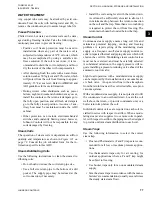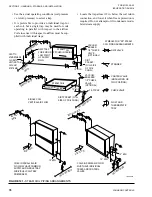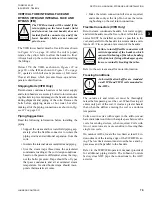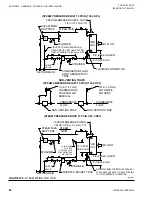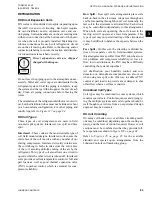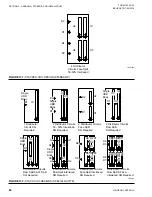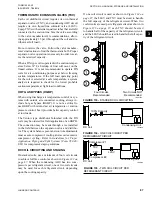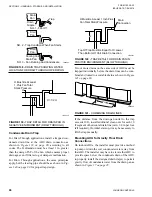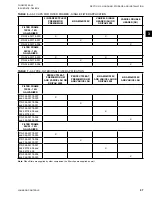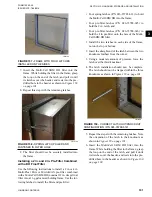
JOHNSON CONTROLS
89
SECTION 3 - HANDLING, STORAGE, AND INSTALLATION
FORM 102.20-N1
ISSUE DATE: 7/06/2016
3
VAV SYSTEMS
Overhead VAV systems are the preferred method of air
distribution because they offer greater energy efficien-
cy and better control of building diversity than constant
volume systems (CVS). Unlike a CVS, in which the
leaving air temperature is adjusted to satisfy the cool-
ing load, the air temperature in a VAV system remains
constant, and the air volume is varied to meet the cool-
ing requirements.
A VAV system has four components:
1.
AHU with airflow control (i.e. Variable Frequen
-
cy Drives (VFDs)),
2. VAV boxes,
3. Zone thermostats, and
4. Duct static pressure sensors.
These components must work together to provide good
temperature control, and a comfortable environment.
The zone thermostats control the VAV boxes. As the
zone temperature increases, the VAV boxes open to al-
low greater airflow into the space, As the zone tem-
perature decreases, the VAV boxes close to decrease
the airflow to the space.
As the VAV boxes open and close, the static pressure
in the ductwork changes. When a box opens, the duct
static pressure decreases, and when a box closes, the
duct static pressure increases. The duct static pressure
sensor controls the AHU supply fan. Since an increase
in duct pressure relates to a decrease in the required
zone airflow, the supply fan volume decreases. Con-
versely, a lower duct static pressure indicates a need for
increased zone airflow; the supply fan volume increas-
es. A change in supply air volume is accomplished us-
ing a VFD or similar device.
In the AHU, a decrease in airflow through the DX coil
will result in a corresponding decrease in the suction
gas pressure while an increase in airflow will result in
an increase in the suction gas pressure. Since the system
is designed to maintain a constant suction gas pressure,
the compressors will be turned on or off, as needed, to
meet the increase or decrease in load demand. The sys-
tem should be designed to operate smoothly, avoiding
transients that could upset system balance and cause
liquid flood back.
Problems can arise if the airflow decreases
more quickly than the compressor control
can respond to the load change. There-
fore, airflow should never change at a
rate faster than 3% per minute on VAV
systems.
This limitation will promote stable control of the sys-
tem and minimize fluctuations in zone temperature.
Under any circumstances, a minimum of 350 FPM
face velocity across the coil must be maintained for
DX split systems.
DRAINS AND TRAPS
Where there is a risk of the liquid freez
-
ing in the trap, heat trace and insulate the
traps to prevent blockage and/or damage.
Auxiliary drain pans may not require
traps. If the trap is not in constant use,
the water seal may evaporate, causing air
passage into or out of the AHU. In these
cases, it is recommended to cap the drain
that allows the opening or closing of the
drain, depending on its use.
Condensate Drain Piping
The majority of cooling coils are located in the AHUs,
so that the supply air is drawn through them, which
results in the condensate being subjected to negative
(-) static pressure. Unless pressure equalization is pro-
vided in the condensate drain, the air rushing back
through the drain pipe will cause the condensate to
build up in the drain pan.
As the AHU continues to operate, the accumulated wa-
ter will be carried with the air stream, overfilling the
drain pan, causing possible water leaks into the supply
duct and/or causing water damage in the building. In-
stall a trap to prevent this condensate water buildup as



